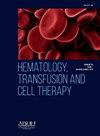COLD AGGLUTININ DISEASE IN A PATIENT WITH WALDENSTRÖM’S MACROGLOBULINEMIA: A DIAGNOSTIC AND THERAPEUTIC CHALLENGE
IF 1.6
Q3 HEMATOLOGY
引用次数: 0
Abstract
Introduction
Cold Agglutinin Disease (CAD) is a form of Autoimmune Hemolytic Anemia (AIHA) caused by IgM antibodies binding to erythrocytes at low temperatures, leading to complement-mediated hemolysis. CAD can be primary (idiopathic) or secondary, often associated with lymphoproliferative disorders, infections, or autoimmune diseases. Waldenström’s Macroglobulinemia (WM), a rare B-cell malignancy characterized by IgM overproduction, is an uncommon but important cause of secondary CAD. This case highlights the diagnostic and therapeutic challenges of CAD in a patient with relapsed WM.
Case presentation
A 66-year-old female was diagnosed with Waldenström’s Macroglobulinemia (WM) in 2012 based on a bone marrow biopsy. She initially received R-CHOP chemotherapy, achieving remission in 2015, followed by Autologous Stem Cell Transplantation (ASCT) in October 2015. After relapse in 2016, she was treated with bortezomib-rituximab followed by bortezomib monotherapy between 2016 and 2018. In October 2023, she started ibrutinib therapy for disease control. During routine blood tests in October 2023, hematologic discrepancies were noted: Hemoglobin (Hb): 7 g/L, Hematocrit (Hct): 13%, which corrected to Hb: 10.5 g/L and Hct: 31.2% after warming the sample to 37°C, raising suspicion for Cold Agglutinin Disease (CAD). Direct Coombs test was positive (1/16 IgM titer), confirming the diagnosis. Given the underlying lymphoproliferative disorder, the patient was started on rituximab therapy for CAD management while continuing ibrutinib for WM.
Conclusion
This case underscores the importance of considering CAD in patients with hematologic malignancies presenting with unexplained anemia and hemoglobin/hematocrit discrepancies. It highlights the necessity of warming blood samples in suspected cases, preventing misinterpretation of CBC results. Additionally, it demonstrates the crucial role of rituximab in managing CAD secondary to WM by targeting IgM-producing B-cells. Early recognition and treatment of secondary CAD in lymphoproliferative disorders can prevent complications and improve patient outcomes.
感冒凝集素病患者waldenstrÖm的大球蛋白血症:诊断和治疗的挑战
冷凝集素病(CAD)是一种自身免疫性溶血性贫血(AIHA),由IgM抗体在低温下与红细胞结合,导致补体介导的溶血引起。CAD可以是原发性(特发性)或继发性,通常与淋巴增生性疾病、感染或自身免疫性疾病有关。Waldenström的巨球蛋白血症(WM)是一种罕见的b细胞恶性肿瘤,以IgM过量产生为特征,是一种罕见但重要的继发性CAD病因。本病例强调了复发性WM患者CAD的诊断和治疗挑战。病例介绍:一名66岁女性于2012年经骨髓活检诊断为Waldenström大球蛋白血症(WM)。她最初接受了R-CHOP化疗,于2015年获得缓解,随后于2015年10月进行了自体干细胞移植(ASCT)。2016年复发后,她在2016年至2018年期间接受了硼替佐米-利妥昔单抗治疗,随后接受了硼替佐米单药治疗。2023年10月,她开始使用依鲁替尼治疗疾病控制。在2023年10月的常规血液检查中,发现血液学差异:血红蛋白(Hb): 7 g/L,红细胞压积(Hct): 13%,将样品加热至37°C后校正为Hb: 10.5 g/L和Hct: 31.2%,引起对冷凝集素病(CAD)的怀疑。直接Coombs试验阳性(1/16 IgM滴度),确诊。考虑到潜在的淋巴增生性疾病,患者开始使用利妥昔单抗治疗CAD,同时继续使用依鲁替尼治疗WM。结论:本病例强调了在出现不明原因贫血和血红蛋白/红细胞压积差异的血液恶性肿瘤患者中考虑CAD的重要性。它强调了在疑似病例中加热血液样本的必要性,以防止对全血细胞计数结果的误解。此外,它还证明了美罗华通过靶向产生igm的b细胞,在管理WM继发性CAD中的关键作用。淋巴增生性疾病继发性CAD的早期识别和治疗可以预防并发症和改善患者的预后。
本文章由计算机程序翻译,如有差异,请以英文原文为准。
求助全文
约1分钟内获得全文
求助全文
来源期刊

Hematology, Transfusion and Cell Therapy
Multiple-
CiteScore
2.40
自引率
4.80%
发文量
1419
审稿时长
30 weeks
 求助内容:
求助内容: 应助结果提醒方式:
应助结果提醒方式:


